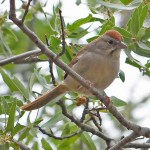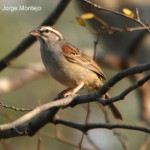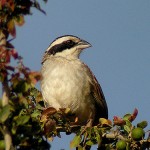The Genus Formerly Known as Aimophila
Recently I explored some of the recent AOU species splits by comparing birdsongs. Today I want to look at a genus that the AOU dramatically chopped and reshuffled: the sparrow genus Aimophila.
Aimophila has long troubled taxonomists. On the one hand, it has traditionally included certain pairs of species — for example, Cassin’s and Botteri’s Sparrows, or Rufous-crowned and Rusty Sparrows — that look nearly identical. On the other hand, it has also included birds that look radically different from one another. In fact, taxonomists have never been able to establish a definitive set of features that distinguishes Aimophila from other sparrows. Unsurprisingly, it turns out that not all the species in the genus share a common ancestry.
 |  |  |
| Still in Aimophila: Rufous-crowned Sparrow. Photo by Jerry Oldenettel (Creative Commons 2.0). | Moved to Peucaea: Sumichrast's (Cinnamon-tailed) Sparrow. Photo by Jorge Montero (Creative Commons 2.0). | Moved to Peucaea: Stripe-headed Sparrow. Photo by Len Blumin (Creative Commons 2.0). |
A DNA study by DaCosta et al. (2009) recently showed that the members of Aimophila were not all each other’s closest relatives — a finding that typically portends a taxonomic rearrangement. Largely on the basis of that study, the AOU recently split Aimophila three ways:
Remain in Aimophila
- Rufous-crowned Sparrow (Aimophila ruficeps)
- Rusty Sparrow (Aimophila rufescens)
- Oaxaca Sparrow (Aimophila notosticta)
Move to Peucaea (a resurrected genus)
- Cinnamon-tailed Sparrow (Peucaea sumichrasti)
- Rufous-winged Sparrow (Peucaea carpalis)
- Stripe-headed Sparrow (Peucaea ruficauda)
- Black-chested Sparrow (Peucaea humeralis)
- Bridled Sparrow (Peucaea mystacalis)
- Botteri’s Sparrow (Peucaea botterii)
- Cassin’s Sparrow (Peucaea cassinii)
- Bachman’s Sparrow (Peucaea aestivalis)
Join Sage and Black-throated Sparrows in Amphispiza
- Five-striped Sparrow (Amphispiza quinquestriata)
I’m going to save Five-striped Sparrow for another day, since it’s a complex topic — but let’s take a look at how the vocalizations of the other two groups give a clue to their taxonomic relationships.
Aimophila nasal chatters
A hallmark of the three species remaining in Aimophila is a short nasal call that often runs into a long fast chatter. Here are examples from two of the three (the Rufous-crowned Sparrow chatter is at the end of the recording):
I couldn’t find online examples of the Oaxaca Sparrow chatter, but Howell and Webb say that it has one:
A slightly nasal, dry, scolding chatter shasha… or chehcheh… suggesting a wren; also a harsh, more excited, often prolonged chattering chii-i-i-i-i-i-ir, accelerating and slowing.
Peucaea rhythmic twitters
The species now in Peucaea don’t appear to give nasal chatters like those above, but many of them do give a unique “rhythmic twitter” — a rapid series of chip notes in which every fourth note or so is audibly different than the majority, giving the whole thing a unique rollicking rhythm. The Black-chested Sparrow of Mexico provides perhaps the best example:
In its complexity, this call sounds much like a song, but the actual song of Black-chested Sparrow is described in Howell & Webb as a separate vocalization:
Song typically a single note followed by a rapid, liquid series of 8-16 notes sometimes accelerating into a trill: swiet, swieswieswieswie… or psu, susususu…, etc.
You can hear one strophe of Black-chested Sparrow song here (the very first vocalization on the cut; the rest is the rhythmic twitter). Howell surmises that the rhythmic twitter may actually be a duet between two birds, and spectrographic analysis seems to support this view: in several examples on the Macaulay Library cut linked above, it seems that one bird often starts or finishes before the other.
Several other species of Peucaea apparently have rhythmic twitters (apparently often or usually duets) in addition to musical songs:
Cinnamon-tailed Sparrow
Rhythmic twitter:
Song:
Rufous-winged Sparrow
Rhythmic twitter:
Song:
Stripe-headed Sparrow
Rhythmic twitter:
Song:
Bridled Sparrow
Rhythmic twitter:
The song can be heard here.
The remaining species in Peucaea are more familiar to American birders: Bachman’s, Botteri’s and Cassin’s Sparrows. They apparently don’t give rhythmic chatters quite the way their Mexican congeners do — or at least not as often — but the literature on all three species describes “excited songs” and/or “pair reunion chatters” that may well correspond to the “rhythmic twitters” above. (There well may be a difference between “excited songs” and “twitter duets” in some of the above species, although I didn’t really draw the distinction this time around. In particular, I know for a fact that only one Cinnamon-tailed Sparrow individual was involved in the production of the “rhythmic twitter” example above, and it was responding aggressively to my playback of the same vocalization — which sounds more like an “excited song” type of behavior than a “twitter duet.” You know what that means — more study needed!)